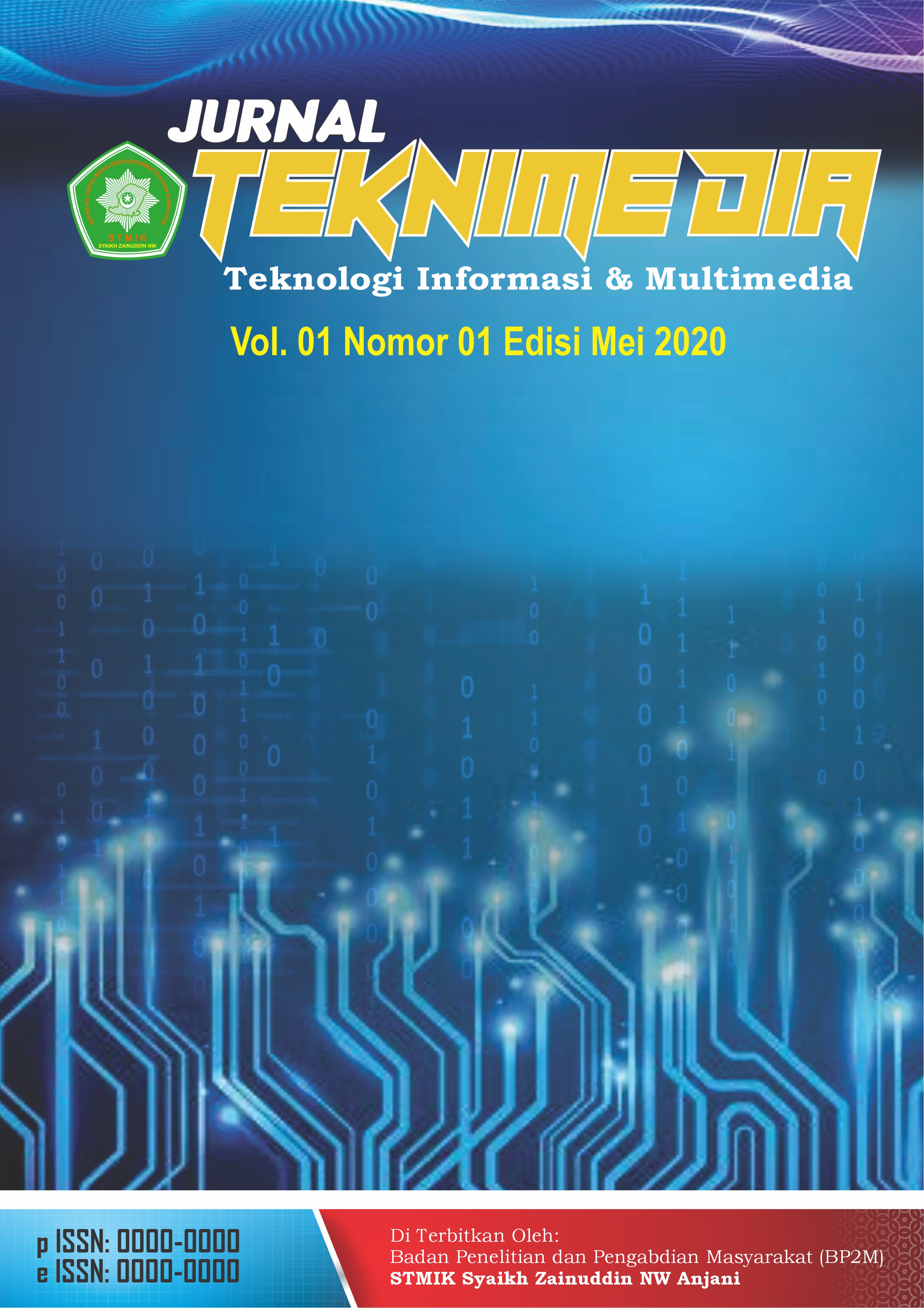PEMANFAATAN DATA INSTAGRAM UNTUK MENGETAHUI REPUTASI TEMPAT WISATA DI LOMBOK
Abstrak
Sosial media saat ini memiliki pengaruh yang sangat luar biasa dalam pengambilan keputusan, termasuk didalam
industri wisata untuk mengetahui reputasi dan popularitas sebuah destinasi wisata. Saat ini penggunaan dan pemanfaatan
media sosial tidak hanya sebatas media hiburan tapi juga sebagai media atau wadah untuk berbagi informasi baik informasi
yang dianggap penting maupun yang tidak penting dan terabaikan. Dalam penelitian ini, kami memanfaatkan data yang
tersebar melalui postingan instagram yang berkaitan dengan destinasi wisata untuk dijadikan refrensi untuk mengetahui
reputasi destinasi wisata yang berada di Pulau Lombok. Data yang digunakan berasal dari Instagram dengan jumlah 600
dataset, dengan menggunakan tiga kata kunci yaitu pantai, gili dan Gunung. Adapun metode yang digunakan adalah Naive
Bayes Classifier yang akan digunakan untuk mengklasifikasi postingan dan komentar instagram dengan pengklasifikasian
kedalam postingan positif, negatif dan netral terhadap destinasi wisata. Hasil dari penelitian ini dapat menunjukkan bahwa
akurasi naive bayes sebesar 59%, sedangkan tempat wisata atau destinasi wisata yang dikategorikan bereputasi populer
untuk pantai yaitu Pantai Kuta dengan presentase 85% dan untuk kategori gili yaitu gili air 47% dan kategori gunung yaitu
Gunung Rinjani dengan prosentase 60%.
Referensi
Y. Mejova, “Sentiment Analysis : An Overview Comprehensive Exam Paper,” Science (80-. )., pp. 1–34,
F. Neri, C. Aliprandi, F. Capeci, M. Cuadros, and T. By, “Sentiment analysis on social media,” Proc. 2012
IEEE/ACM Int. Conf. Adv. Soc. Networks Anal. Mining, ASONAM 2012, pp. 919–926, 2012, doi: 10.1109/ASONAM.2012.164.
K. Lerman and R. Ghosh, “Information contagion: An empirical study of the spread of news on Digg and Twitter social networks,” ICWSM 2010 - Proc. 4th Int. AAAI Conf. Weblogs Soc. Media, pp. 90–97, 2010.
E. Jean and P. Ed, “Local and Global Responses to Disaster : # eqnz and the Christchurch Earthquake Associate Professor Axel Bruns ARC Centre of Excellence for Creative Industries & Innovation Queensland University of Technology , Brisbane , Australia ARC Centre of Excellenc,” Disaster Emerg. Manag. Conf. Conf. Proc.,
pp. 86–103, 2012.
M. S. Neethu and R. Rajasree, “Sentiment analysis in twitter using machine learning techniques,” 2013 4th
Int. Conf. Comput. Commun. Netw. Technol. ICCCNT 2013, 2013, doi: 10.1109/ICCCNT.2013.6726818.
V. Narayanan, I. Arora, and A. Bhatia, “Fast and accurate sentiment classification using an enhanced Naive Bayes model,” Lect. Notes Comput. Sci. (including Subser. Lect. Notes Artif. Intell. Lect. Notes Bioinformatics), vol. 8206 LNCS, pp. 194–201, 2013, doi: 10.1007/978-3-642-41278-3_24.
P. Chesley, B. Vincent, L. Xu, and R. K. Srihari, “Using verbs and adjectives to automatically classify blog sentiment,” AAAI Spring Symp. - Tech. Rep., vol. SS-06-03, pp. 27–29, 2006.
M. Gamon, A. Aue, S. Corston-Oliver, and E. Ringger, “Pulse: Mining customer opinions from free text,” Lect.
Notes Comput. Sci. (including Subser. Lect. Notes Artif. Intell. Lect. Notes Bioinformatics), vol. 3646 LNCS, pp.
–132, 2005, doi: 10.1007/11552253_12.
“SENTIMENT CLASSIFICATION OF MOVIE REVIEWS USING LINGUISTIC PARSING Brian Eriksson CS 838 - Natural Language Processing Final Project Report,” pp. 4–9.
Liu.B, Opinion Mining. Chicago, United States of America, 2012.
Q. Ye, Z. Zhang, and R. Law, “Sentiment classification of online reviews to travel destinations by supervised machine learning approaches,” Expert Syst. Appl., vol. 36, no. 3 PART 2, pp. 6527–6535, 2009, doi: 10.1016/j.eswa.2008.07.035.
K. D. Mukhina, S. V. Rakitin, and A. A. Visheratin, “Detection of tourists attraction points using Instagram
profiles,” Procedia Comput. Sci., vol. 108, no. June, pp. 2378–2382, 2017, doi: 10.1016/j.procs.2017.05.131.
Y. Wang and B. Li, “Sentiment Analysis for Social Media Images,” Proc. - 15th IEEE Int. Conf. Data Min.
Work. ICDMW 2015, pp. 1584–1591, 2016, doi: 10.1109/ICDMW.2015.142.
A. Sinaga, “Implementasi Sentiment Analysis untuk Menentukan Tingkat Popularitas Tujuan Wisata,” Pros.
Semin. Nas. Teknol. dan Rekayasa Inf. Tahun 2017, no. November, pp. 24–25, 2017.
I. Rish, “An empirical study of the naive Bayes classifier,” Phys. Chem. Chem. Phys., vol. 3, no. 22, pp.
–4869, 2001, doi: 10.1039/b104835j.
M. Murnawan, “Pemanfaatan Analisis Sentimen Untuk Pemeringkatan Popularitas Tujuan Wisata,” J.
Penelit. Pos dan Inform., vol. 7, no. 2, p. 109, 2017, doi: 10.17933/jppi.2017.070203.
J. Ren, S. D. Lee, X. Chen, B. Kao, R. Cheng, and D. Cheung, “Naive bayes classification of uncertain data,”
Proc. - IEEE Int. Conf. Data Mining, ICDM, no. 60703110, pp. 944–949, 2009, doi:
1109/ICDM.2009.90.
E. W. Sandi Fajar Rodiyansyah, “Klasifikasi Posting Twitter Kemacetan Lalu Lintas Kota Bandung
Menggunakan Naive Bayesian Classification,” IJCCS, vol. Vol. 6, No.
J. Han and M. Kambe, Data Mining: Concepts and Techniques 2e, 2E ed. San Fransisco: Morgan Kaufmann Publishers, 2006.
and H. S. C. D. Manning, P. Raghavan, Introduction to Information Retrieval. California: Cambridge University Press, 2008.
K. Tan, Steinbach, Karpatne, “Data Mining : Data Lecture Notes for Chapter 2 Introduction to Data Mining by What is Data ?,” Ratio, 2004.
##submission.copyrightStatement##
##submission.license.cc.by-sa4.footer##Semua tulisan pada jurnal ini menjadi tanggungjawab penuh penulis. Jurnal Teknimedia memberikan akses terbuka terhadap siapapun agar informasi dan temuan pada artikel tersebut bermanfaat bagi semua orang. Jurnal Teknimedia dapat diakses dan diunduh secara gratis, tanpa dipungut biaya, sesuai dengan lisensi creative commons yang digunakan.

Jurnal TEKNIMEDIA : Teknologi Informasi dan Multimedia is licensed under a Lisensi Creative Commons Atribusi-BerbagiSerupa 4.0 Internasional


.png)





